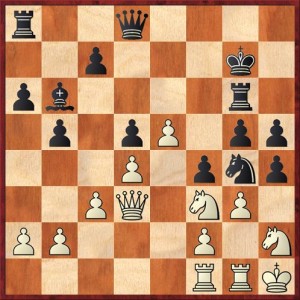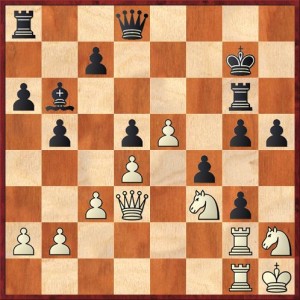… and the reason I love it is that speed chess is ridiculously entertaining.
… and the reason I hate it is that speed chess magnifies all of my worst tendencies.
Both of these reason were on full display in a mind-boggling speed game that I played with Linnea yesterday after the Aptos Library chess club was over. Here is the position where the mind-bogglingness started. I’m playing Black, Linnea is White, and it’s my move.
FEN: r2q4/2p3k1/pb4r1/1p1pP1pp/3P1pnp/2PQ1NP1/PP3P1N/5RRK b – – 0 1
Up to this point I’ve been having a merry old time pushing all of my kingside pawns, but after Linnea’s move 1. g3 I started to get a whiff of trouble in paradise. On any pawn capture, the lines start opening up in an uncomfortable way around my king. And the knight on g4 is just in the way, making it hard for me to avoid the pawn captures. Is there anything I can do about this?
Here I found what Rybka says is Black’s one and only correct move: 1. … Nxf2+! According to the computer, Black is now +1.9 pawns, and on any other move I would have been 0.0 or worse. So, huge props to me, right?
Well, not so much. The problem is that after finding the only way out of trouble (temporarily), I didn’t think very hard about what got me into trouble in the first place. I played the next couple of moves on auto-pilot. Linnea played 2. Rxf2 g3 3. R2g2! and now we got to the most crucial position.
FEN:r2q4/2p3k1/pb4r1/1p1pP1pp/3P1p2/2PQ1Np1/PP4RN/6RK b – – 0 3
John Emms’ The Ultimate Chess Puzzle Book has a great chapter called “Find the Wrong Move!” This chapter is full of positions where somebody plays a move that seems completely natural and plausible, and yet is practically the worst move on the board. The above position would be a perfect one for that chapter. Find the wrong move!
We were playing speed chess, remember. So I gave this position about 5 seconds thought, if that much, and played 3. … gh?? The “automatic recapture.” The only reason I even thought that long is that I had to check and make sure I wasn’t getting mated after 4. Rxg5. (I’m not getting mated because I play 4. … hgQ+, queening with check and removing the guard all at the same time.)
What I missed is that Linnea can simply recapture on h2: 4. Rxh2! At this point my reaction went through the five stages of grief.
Denial: Okay, she’s threatening to take on h5 and she’s threatening to take on g5 and she’s threatening Nh4 (the real killer), but surely I can do something about those things, right?
Anger: This is ridiculous, how could I be losing this game? I’ve been winning for like 20 moves, and now all of a sudden there’s nothing I can do?
Bargaining: Okay, how about if I give back a little bit of material. Say, … Qd7 or … Qh8?
Depression: I have got to be the worst speed chess player in history. How can I pretend to be a “teacher” when I do things like this?
Acceptance: Oh well, it’s only speed chess. I played 4. … Kh6 5. Nh4 Rg8 6. Nf5+ and resigned.
The computer, of course, doesn’t go through the five stages of grief. Rybka simply says that after 4. Rxh2 White stands at +1.8 pawns. That’s right, one “automatic recapture” transformed the position from 1.9 pawns in Black’s favor to 1.8 pawns in White’s favor. Rarely have I ever seen a position where the seemingly obvious move was so radically, outrageously wrong.
As I drove home in my car, it hit me that of course, there was no need for me to take the knight. It’s not going anywhere. I could have played 4. … g4, which puts another knight under attack and, more importantly, clears a path to h4 for the queen. It’s critically important for Black to keep the four pawns on the board until he can bring up reinforcements. In particular, the g3 pawn is a monster that paralyzes White’s whole army. This pawn is worth more than a knight.
The tactical details after 4. … g4 are quite complicated and I could give my analysis here, but I think that would kind of miss the point.
In order to learn from this game, we need to ask not, “What can Black do better after this point?” but “What did Black do badly before this point?” Look at those queenside pieces. The queen has never moved. The queen rook has never moved. The dark-squared bishop might as well be a pawn, for all the effect it’s having on the game. Black is trying to attack with three of his pieces as bystanders. This is not a good idea.
Lesson 1: Invite all of your pieces to the party. Don’t launch an all-out attack until you have completed your development. The price of this failure became apparent after 4. Rxh2. I’d like to move my rook to h8 or my bishop to d8, but those all take two or three moves and I don’t have that much time. The time to improve those pieces was earlier.
In fact, the same thing is true for the position after the supposedly good move 3. … g4. It’s actually quite debatable whether this is Black’s “best move,” as Rybka says, because it doesn’t actually solve the problem of the bystanders on the queenside. The position remains quite perilous, where one misstep for Black can easily turn his won position into a lost cause. For this reason, I think that the best move is actually Rybka’s second choice, 3. … Qe7 (which it rates at +1.7 for Black). Black’s plan is simply to prevent any breakthroughs with e5-e6, develop his queenside pieces, and only then start to march the kingside pawns again. If White wants to move her knight away from h2, let her do it. Once Black’s pawns have pieces behind them, White will not be able to stop them without sacrificing some material.
This is the practical, sound way to play the position. It carries very little risk of disaster. It’s Mike Splane chess. Even though he’s very good at tactics (see my last post!) he is always in favor of having the tactics flow from a sound strategy. I can almost hear him saying, “To win a won position, first eliminate all of your opponent’s chances of counterplay.”
As I said at the outset, speed chess magnifies all of my bad tendencies. Here’s what I did wrong in the game: I launched a pawn storm prematurely. I didn’t develop all of my pieces. I had “tunnel vision,” focusing only on the kingside and forgetting the rest of the board. I played an “automatic recapture,” without even thinking about my opponent’s response or other options for me. (In fact this is important enough for me to make it another lesson:
Lesson 2: There are no automatic recaptures.)
Immediately after the game I was stunned by the fact that my position had gone from won to lost in the blink of an eye. But once you look at the position from the perspective of the whole game, you realize that I had sown the seeds of my defeat much earlier. They were all there, waiting to bloom like a huge carrion flower.
So speed chess is frustrating. But it’s also ridiculously entertaining, I’ve got to admit.
By the way, I’ve scarcely written one word about Linnea, and that’s unfair. She made mistakes, obviously, but on the whole she played more practically than I did and deserved to win. Notice how in the initial position she has invited all of her pieces to the party, even if the knights are looking somewhat forlorn. (That was her biggest problem in this game, figuring out what to do with the knights.)
Linnea will be playing in the “Best of the West” open this weekend in Santa Clara, a big tournament with a whopping $1500 prize for first in the 1300-1499 section. I am super-optimistic about her chances. I mean, she’s beating masters in speed chess. (Not just me, a poor speed chess player. She also beat Gjon, an excellent speed chess player, in one game this weekend.) The challenge for her is the opposite of mine; she hasn’t yet learned how to use the extra time in a tournament game effectively. But she will!





{ 2 comments… read them below or add one }
My first instinct in the second diagram was 3 … h4
Yes, 3. … h4 is a move that occurred to me after I realized the importance of keeping the four-pawn mass intact. It is the most solid formation of all. But 4. Qf5 is a bit of an issue. (Actually, 4. Qf5 needs to be analyzed carefully after 3. … g4 as well, but 4. … gf turns out to be a strong enough answer.) I still think that on principle, 3. … Qe7 is the way to go because it begins to address Black’s biggest problem, which is the lack of involvement of his queenside pieces.
On another subject, yesterday I recorded a ChessLecture about your game with Damian Nash. It’ll probably be a month or two before it goes online. The lecture will be called “Awesome State Champions: Brian’s Birthday Bash.”